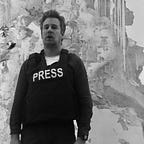Armenia’s civilian army is tasked with building ‘a strong country’
Hugh Bohane
Voma volunteers line up for roll call. Picture: © Hugh Bohane
On September 13, Azerbaijani forces attacked three southern border cities of Armenia resulting in the deaths of over 200 Armenian soldiers. Consequently, Azerbaijan’s military lost 80 of their servicemen in retaliatory fighting. Azerbaijani and Armenian officials have accused each other of instigating the violent escalation.
In the days following the September attacks by Azerbaijani troops, Armenia’s largest volunteer civilian army: Voma, recruited hundreds of new civilian members from around the country.
Voma is an NGO, that was founded in 2014 and is mainly funded by the Armenian diaspora. The NGO’s main mission is to train Armenian civilians (sixteen years and over) in first aid, firearms and survival training among other practical courses.
One of the organization’s future objectives is to have a trained reservist army consisting of up to 600,000 personnel nationwide.
It is important to note that Armenia’s current population is 2.9 million and meanwhile Azerbaijan’s is 10.3 million. Additionally, Azerbaijan has a much higher birth rate and a larger army than Armenia.
Pro-Azerbaijan media considers Voma a “terrorist organization” and the Prosecutor General’s Office of Azerbaijan initiated a criminal case against Voma operating in Nagorno-Karabakh back in 2020.
Voma’s first-aid instructor Satie Muradyan at the Voma Yerevan centre. Picture: © Hugh Bohane
I recently toured Voma’s Yerevan centre and was accompanied by Satie Muradyan, a twenty-one-year-old first-aid instructor, to see firsthand how the training is conducted, especially in the aftermath of Azerbaijan’s recent violation on Armenian soil.
“We now have over 300 volunteers training at our centre and we are conducting ‘quick’ ten-day training at the moment,” said Muradyan.
“One of Voma’s main initiatives is to make people understand that training is necessary and to be prepared for everything, which does not mean that we want war, not at all, we want peace and we train for peace.
“There is a saying in Armenia, if the Azerbaijanis put their weapons down there will be peace, if the Armenians put their weapons down there will be war,” Muradyan said.
Voma’s Yerevan centre was purchased in 2014 and inside the building, there is a climbing gym, a floor section where extreme first-aid medical courses and combat training are carried out (with wooden or rubber guns), a knife-throwing space, a kitchen and an office.
Volunteers do physical training in the surrounding outdoor garden area as well as firearms target practice. When I visited the group, I noticed a mix of males and females training from late teens up to older members in their sixties. Most of the members were dressed in camouflaged military fatigues with an Armenian flag badge sewn onto their right arm shirtsleeve.
Voma volunteers conduct physical training. Picture: © Hugh Bohane
“Many sixteen and seventeen-year-old boys come here before they go into the army so they can prepare how to shoot and clean a gun and learn gun safety; not to point a gun at a person even if they are rubber guns,” said Muradyan.
Muradyan added that Voma’s training can also be beneficial for young women who wish to learn vital skills in self-defence that can help them not just on the battlefield but also in their everyday lives.
“Almost all of Voma’s trainers you can see here tonight, if they were not involved in the [2020 Nagorno-Karabakh] war they were here in Yerevan training volunteers,” Muradyan said.
During the 2020 Nagorno-Karabakh war, Voma was instrumental in live combat operations and in protecting villages in the disputed region.
Throughout the 2020 war, it was quite common for young people like Muradyan, to skip university or school classes and abandon their normal schedule to help in the war effort. Muradyan spent the duration of that war teaching first aid every day to hundreds of volunteers at the Voma Yerevan centre.
A Voma volunteer learns first-aid. Picture: © Hugh Bohane
“That was a very difficult time and even though we lost that war I didn’t feel that all I did was a waste of time because even if people don’t use first-aid training on the battlefield they can use it in their everyday lives,” said Muradyan.
The recent military aggression from Azerbaijan hasn’t garnered nearly as much media attention or united the international world to the same extent as what Ukraine has experienced lately and I asked Muradyan what her thoughts were on that issue.
“Of course, there is sadness, disappointment and even a little bit of anger about that for Armenia, I wish there would be more conversation about what is happening here as there is in Ukraine but I also understand that we are just a small country and this conflict has been going on for a long time,” said Muradyan.
Voma volunteers learning how to use guns. Picture: © Hugh Bohane
I also sat down with the vice president of Voma, Vaghinak Vartanov, as the evening’s activities ended.
“The stronger the people, the stronger the country… we want to build a strong country that is militarily prepared much like Switzerland,” said Vartanov.
Vartanov went on to say that, on the whole, Armenia’s people want peace and to achieve that the country needs to be more militarily strong.
“Armenia is surrounded by four large countries and our whole nation needs to be united as one army. We are not an aggressive nation and we are just taking necessary steps to defend our country,” said Vartanov.
According to Vartanov, Voma’s future goals are to unite the country and to have Voma centres and other civilian army centres in every region of Armenia.
“If Armenians can unite and help their country then maybe more countries will support us in the future,” said Vartanov.
Hugh Bohane is an Australian multimedia freelance journalist who covers conflict and is currently based in Yerevan.
